Rnsg 1443 cancer - Study guides, Class notes & Summaries
Looking for the best study guides, study notes and summaries about Rnsg 1443 cancer? On this page you'll find 11 study documents about Rnsg 1443 cancer.
All 11 results
Sort by
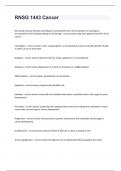
-
RNSG 1443 Cancer questions with answers
- Exam (elaborations) • 3 pages • 2024
- Available in package deal
-
- $9.99
- + learn more
RNSG 1443 CancerDecreased immune function (surveillance), increased life-time risk of exposure to carcinogens, accumulation of free radicals leading to cell damage - correct answer why does aging increase the risk of cancer? Carcinogens - correct answer cancer causing agents; can be genotoxic (cause irreversible genetic change in cells); can act as promoters Dysplasia - correct answer abnormal cell size, shape, appearance, or arrangement Anaplasia - correct answer Regression of a cell t...
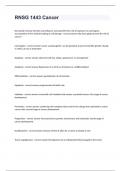
-
RNSG 1443 Cancer questions well answered
- Exam (elaborations) • 3 pages • 2024
- Available in package deal
-
- $9.99
- + learn more
RNSG 1443 CancerDecreased immune function (surveillance), increased life-time risk of exposure to carcinogens, accumulation of free radicals leading to cell damage - correct answer why does aging increase the risk of cancer? Carcinogens - correct answer cancer causing agents; can be genotoxic (cause irreversible genetic change in cells); can act as promoters Dysplasia - correct answer abnormal cell size, shape, appearance, or arrangement Anaplasia - correct answer Regression of a cell t...
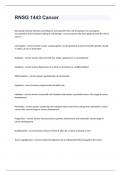
-
RNSG 1443 Cancer Question and answers verified to pass
- Exam (elaborations) • 3 pages • 2024
-
Available in package deal
-
- $14.49
- + learn more
RNSG 1443 Cancer Question and answers verified to passRNSG 1443 Cancer Decreased immune function (surveillance), increased life-time risk of exposure to carcinogens, accumulation of free radicals leading to cell damage - correct answer why does aging increase the risk of cancer? Carcinogens - correct answer cancer causing agents; can be genotoxic (cause irreversible genetic change in cells); can act as promoters Dysplasia - correct answer abnormal cell size, shape, appearance, or arra...
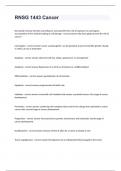
-
RNSG 1443 Cancer questions and answers certified 2024
- Exam (elaborations) • 3 pages • 2024
- Available in package deal
-
- $13.49
- + learn more
RNSG 1443 Cancer questions and answers certified 2024
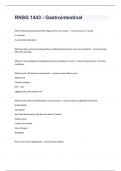
-
RNSG 1443 - Gastrointestinal fully solved
- Exam (elaborations) • 10 pages • 2024
- Available in package deal
-
- $15.49
- + learn more
RNSG 1443 - GastrointestinalWhat is the postoperative priority diagnoses for oral cancer? - correct answer 1. airway 2. nutrition 3. prevention/education What are three common postoperative nutritional therapies for oral cancer patients? - correct answer PEG, TPN, NG tube Where in the esophagus is esophageal cancer most likely to occur? - correct answer Lower 2/3 of the esophagus What are the risk factors of oral cancer? - correct answer Tobacco use Alcohol use Chronic irritation H...
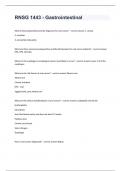
-
RNSG 1443 - Gastrointestinal questions with complete solutions
- Exam (elaborations) • 10 pages • 2024
- Available in package deal
-
- $12.99
- + learn more
RNSG 1443 - GastrointestinalWhat is the postoperative priority diagnoses for oral cancer? - correct answer 1. airway 2. nutrition 3. prevention/education What are three common postoperative nutritional therapies for oral cancer patients? - correct answer PEG, TPN, NG tube Where in the esophagus is esophageal cancer most likely to occur? - correct answer Lower 2/3 of the esophagus What are the risk factors of oral cancer? - correct answer Tobacco use Alcohol use Chronic irritation H...
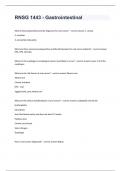
-
RNSG 1443 - Gastrointestinal Question and answers correctly solved
- Exam (elaborations) • 10 pages • 2024
-
Available in package deal
-
- $13.99
- + learn more
RNSG 1443 - Gastrointestinal Question and answers correctly solved RNSG 1443 - Gastrointestinal What is the postoperative priority diagnoses for oral cancer? - correct answer 1. airway 2. nutrition 3. prevention/education What are three common postoperative nutritional therapies for oral cancer patients? - correct answer PEG, TPN, NG tube Where in the esophagus is esophageal cancer most likely to occur? - correct answer Lower 2/3 of the esophagus What are the risk factors of oral...
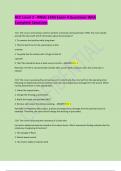
-
ACC Level 2 - RNSG 1443 Exam 4 Questions With Complete Solutions
- Exam (elaborations) • 29 pages • 2024
-
- $7.49
- + learn more
ACC Level 2 - RNSG 1443 Exam 4 Questions With Complete Solutions .515. The nurse is instructing a client to perform a testicular self-examination (TSE). The nurse should provide the client with which information about the procedure? 1. To examine the testicles while lying down 2. That the best time for the examination is after a shower 3. To gently feel the testicle with 1 finger to feel for a growth 4. That TSEs should be done at least every 6 months - ANSWER-515. 2 Rationale: The TSE...
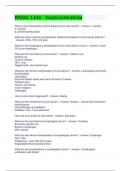
-
RNSG 1443 - GASTROINTESTINAL QUESTIONS AND ANSWERS
- Exam (elaborations) • 6 pages • 2024
-
- $9.49
- + learn more
RNSG 1443 - Gastrointestinal What is the postoperative priority diagnoses for oral cancer? - Answer- 1. airway 2. nutrition 3. prevention/education What are three common postoperative nutritional therapies for oral cancer patients? - Answer- PEG, TPN, NG tube Where in the esophagus is esophageal cancer most likely to occur? - Answer- Lower 2/3 of the esophagus What are the risk factors of oral cancer? - Answer- Tobacco use Alcohol use Chronic irritation HPV - oral Jagged teeth,...
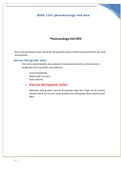
-
RNSG 1443 pharmacology-exit-hesi latest
- Exam (elaborations) • 31 pages • 2023
-
- $12.49
- + learn more
RNSG 1443 pharmacology-exit-hesi Pharmacology Exit HESI Nurse should observe most closely for drug toxicity when a client receivesmed that has what characteristic Narrow therapeutic index The nurse should observe most closely for drug toxicity when a client receives a medication that has which characteristic? • Low bioavailability • Rapid onset of action • Short half life • Narrow therapeutic index. • Rationale: A drug with a narrow therapeutic index has a hig...

How did he do that? By selling his study resources on Stuvia. Try it yourself! Discover all about earning on Stuvia


